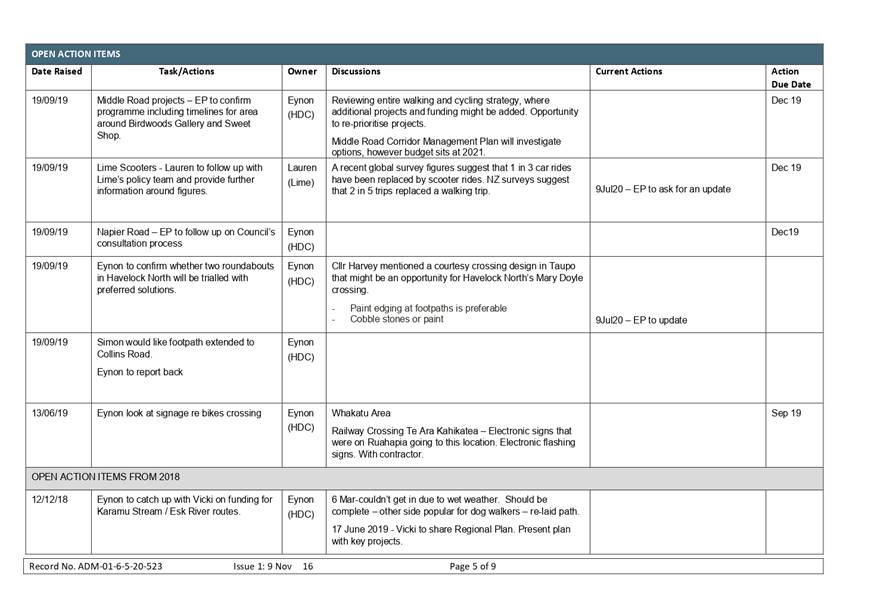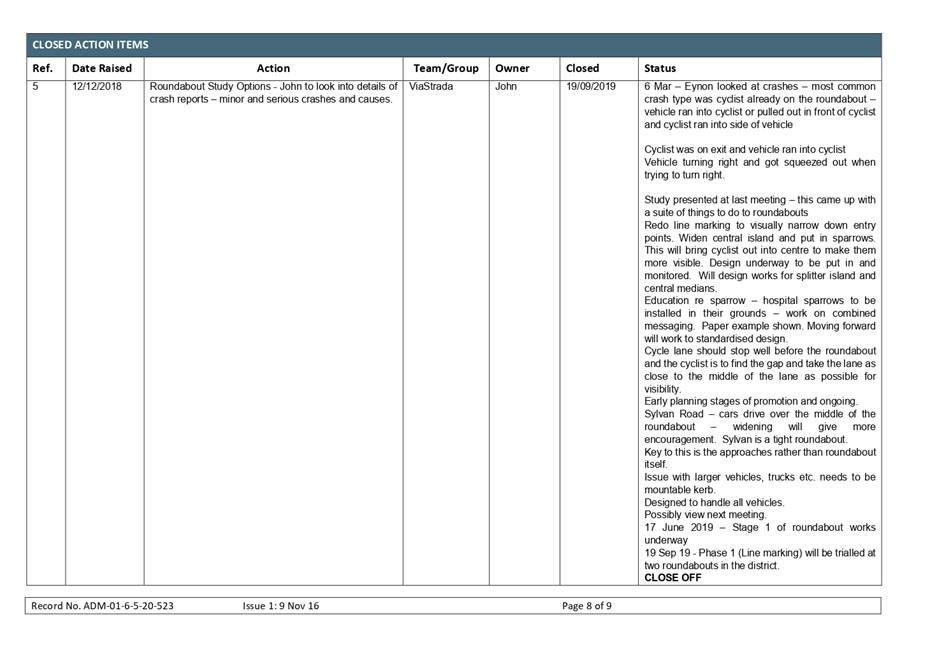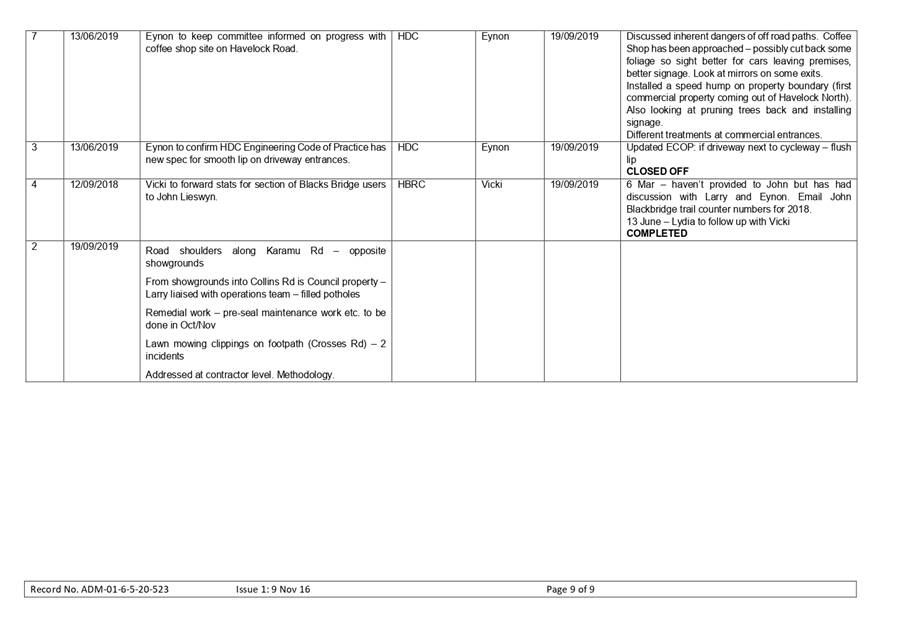Kaupapataka
Open Agenda
|
Te Rā Hui:
Meeting date:
|
Thursday, 30 July 2020
|
|
Te Wā:
Time:
|
3.45pm
|
|
Te Wāhi:
Venue:
|
Landmarks Room
Ground Floor
Civic Administration
Building
Lyndon Road East
Hastings
|
|
Te Hoapā:
Contact:
|
Democracy
and Governance services
P: 06 871 5000
| E: democracy@hdc.govt.nz
|
|
Te Āpiha Matua:
Responsible Officer:
|
Acting Group Manager: Community Wellbeing & Services -
Dennise Elers
|
Hastings District Youth Council – Terms of
Reference 2020
The purpose of the Hastings District Youth Council
(Youth Council)
The Hastings District Council recognises the positive
contribution young people make to a strong, diverse, resilient and inclusive
community. The Hastings District Youth Council is a vehicle in which young
people can be actively engaged in local government planning and decision making
relating to their city.
The Youth Council is responsible for creating dynamic
engagement opportunities for young people to participate in, be heard and be
involved in community activities and government decisions.
The Youth Council’s objective is to canvas youth
opinions on a range of topics, to then advocate and implement changes on behalf
of the young people in Hastings.
Membership
The Youth Council is made up of 19 young people who
live, work, and/or attend school in the Hastings District. Members can be
aged between 15 and 21 years of age.
Youth Council membership is for a period of one year
running from February to December. Applications can be made to the Youth Connector
to continue as a Youth Council member for consecutive years.
Recruitment and Selection of Youth Council Members
Recruitment for Youth Council members runs January-
February each year through local high schools, youth services and community
groups, the Hastings District Council website and various social media
accounts.
All applications must be submitted via the Hastings
District Council’s website. A shortlist of candidates is created, with
those applicants asked to attend a 10 minute interview. The selection panel is
made up of HDC Youth Development staff, a Councillor, and a young person under
the age of 25.
Commitments of Youth Council members
Youth Council members are required to
-
Attend a Youth Council Training
and Planning event, held at the beginning of the year. (After the Council
members have been selected).
-
Elect members to take on
leadership positions such as (but not limited to) the Chair and Deputy
Chairperson of the Youth Council for that year.
-
Contribute to the Youth Council
Annual Plan – that details the focus of the group and their activities
for the year.
-
Attend all official Youth Council
meetings – held fortnightly on Wednesdays at Hastings District
Council’s main offices, with every second meeting being an informal
meeting.
-
Submit formal reports detailing
their actions as a Youth Council member each month at the official Youth
Council meetings.
-
Attend other informal meetings
throughout the year to work on upcoming projects – Members will be given
no less than 2 weeks’ notice of informal meetings.
-
Attend Hastings District Council
meetings for presentations as and when required – Members will be given
no less than 4 weeks’ notice of these presentations.
-
Attend and support all youth,
community and Council events determined in the Annual Plan and by the Youth
Council as a whole.
Meetings:
Youth Council meetings are held at the Hastings
District Council, from 3.45 to 5.30pm.
Meetings will continue as scheduled if they fall in
the school holidays. It is expected that members will attend these meetings
unless they tender their apologies.
The Youth Connector and a Hastings District
Councillor, acting as a Council Liaison, will attend all official Youth Council
meetings.
Youth Council Roles and Responsibilities
Chairperson:
-
The Chairperson chairs each
meeting and ensures everyone contributes to the discussion and that the views
of young people from the whole district are considered when decisions need to
be made.
-
Keeps meetings, projects, planning
and submission processes on track.
-
Delegate’s responsibilities
to members, follows up and ensure the work gets done.
-
Acts as the contact person for the
Youth Council for the public, the media, and Council.
-
Represents the Youth Council at
public forums as required.
-
Works with elected Youth Council
members to manage the official Youth Council social media accounts.
-
Takes action if members repeatedly
do not attend meetings or deliver on actions they say they will undertake.
Deputy Chairperson:
-
Works closely with, and provides
support to the Chairperson.
-
Will take over the Chair’s
responsibilities for running the meetings as required.
-
Will represent the Youth Council
at public forums as required.
-
Works with elected Youth Council
members to manage the official Youth Council social media accounts.
Social Media Team Responsibilities:
-
Works closely with each other, the
Chairperson and the Deputy Chairperson to actively drive traffic to the
official Hastings Youth Council social media accounts.
-
All posts are to be deemed
appropriate under the official Youth Council Social Media Guidelines.
-
To answer all comments and
questions made on social media accounts in a timely and appropriate manner.
-
To report anything of a concerning
nature to the Youth Connector immediately.
-
To promote the Youth Council
activities, and activities/events and campaigns endorsed by Youth Council.
-
Submit a monthly report detailing
engagement.
Youth Council members’ Responsibilities:
-
Attend meetings appropriately
prepared, including submitting their official monthly report of engagements and
activities as a Youth Council member.
-
Actively consult with your
schools, community groups, and young people to find out what they need, want or
are concerned about and bring this information to the Youth Council meetings.
-
Support and promote Youth Council
activities, events and campaigns and those endorsed by Youth Council.
-
Participate in training
opportunities as they arise.
-
To take up leadership and teamwork
opportunities to ensure Youth Council activities, events and campaigns are
delivered successfully and to determined deadlines.
Meeting Process:
Formal meetings are used for:
-
Planning and scheduling Youth
Council projects.
-
Discussing issues that are
affecting young people in the Hastings Community.
-
Presentations and consultancy from
external parties.
-
Decision making about Youth
Council participation and endorsement of community activities.
-
Decision making about Youth
Council events or projects.
Decision making:
Decision making will follow Council’s basic Standard
Order process:
-
Someone will need to move
(propose) a recommendation – which then becomes a Motion;
-
Someone will second the Motion,
then;
-
All members will vote on the
Motion. If the Majority of members agree with the decision it is then carried
(confirmed) and recorded as a Decision.
-
If members cannot agree on a
Decision, the Chairperson will have the deciding vote.
Quorum:
A minimum of half of the Youth Council members must
attend the meeting for it to proceed, 10 people make a quorum.
Agendas and minutes
A final agenda (approved by the chairperson) is to be
sent out to all members and Council representatives at least two working days
prior to the meeting.
Official agendas and minutes will be produced by the
Hastings Council’s Democracy and Governance support team. Agendas and any
attachments will be emailed to members a week before meetings. Minutes will be
emailed to members no more than a week after official meetings.
Apologies:
If a member is unable to attend an official Youth
Council meeting they must tender their apologies to the Chairperson, the Youth
Connector or the Democracy and Governance Advisor looking after the Youth
Council no later than a week before the meeting.
It is expected the member will still submit their
monthly report, detailing their activities related to Youth Council.
Missing more than 2 official meetings in a row without
tendering apologies will result in the member forfeiting their place on the
Youth Council.
Kaupapataka
Open Agenda
|
Nga mema o te
Komiti
Committee Members:
|
Heamana
Chair: Sophie Jones (Karamu High School)
Tawhirimakea Karaitiana and Tiaki Mildon (E.I.T.);
Charlene Fun-nell, Thea Morton, Romona Wainohu, Keelan Heesterman, Brooke
Hemmings and Ondre Hapuku-Lambert (Deputy Chair) (Karamu High School); Lucas
d’Arbois de Jubainville and Finley Robert Duncan (Lindisfarne College);
Olivia Omur-Mackenzie, Zoe Smith and Eva Harper (Hastings Girls High School);
Matilda Ellis (Woodford House); Sam Wixon (HNHS); Louis Gaffaney (St Johns
College); Daisy Hill (Iona); and Janicka Tei (Taradale High)
Council Liaison - Councillor Wendy Schollum
|
|
Tokamatua:
Quorum:
|
10 members
|
|
Apiha Matua
Officer Responsible:
|
Acting Group Manager: Community
Wellbeing & Services - Dennise Elers
|
|
Te
Rōpū Manapori me te Kāwanatanga
Democracy & Governance
Services:
|
Christine Hilton (Extn 5633)
|
Te Rārangi Take
Order of Business
|
1.0
|
Apologies
& Leave of Absence – Ngā Whakapāhatanga me te Wehenga ā-Hui
At the close of the agenda
no apologies had been received.
At the close of the agenda no
requests for leave of absence had been received.
|
|
|
2.0
|
Confirmation
of Minutes –
Te Whakamana i Ngā Miniti
Minutes of the
Hastings Youth Council Meeting held Wednesday 29 July 2020.
(Previously circulated)
|
|
|
3.0
|
Facebook
Page Update
|
|
|
4.0
|
General
Business
|
|
|
5.0
|
HDC
Youth Council Upcoming Events
|
9
|
|
6.0
|
HDC
Youth Council Updates
|
11
|
|
7.0
|
Active
Transport Group Sub-committee Youth Representative
|
75
|
Hastings
District Council: Hastings Youth Council Meeting
Te Rārangi Take
Report to Hastings District Youth Council
|
Nā:
From:
|
Pip Dixon, Youth Connector
|
|
Te Take:
Subject:
|
HDC Youth Council
Upcoming Events
|
1.0 PURPOSE AND SUMMARY - TE
KAUPAPA ME TE WHAKARĀPOPOTOTANGA
1.1 The
purpose of this report it to table 3 events that the Youth Council may
choose to support and attend;
· Combined
Hastings, Regional & Napier Youth Councils.
· Blossom
Parade.
· Rainbow
dash.
2.0 Background – Te Horopaki
Combined meeting between NCC Youth
Council, HBRC Youth Council and HDC Youth Councils
2.1 The Youth Council have
received an invitation from Jake Brookie from the Hawke’s Bay Regional
Council. The purpose is to discuss climate change and the proposed
“Climate Camp”. This will be held at the Napier Aquarium on
Wednesday 26th August at 4pm. If the youth councillors arrive early
they will be given a free tour of the Aquarium.
Blossom Parade
2.1.1 The youth council has received an invitation
from Tanya Jackson, HDC Event Manager. To participate in the
Hastings District Blossom Parade to be held on 12th September. Also
to help decorate the HDC Float and be part of the parade, the theme is
“Flower Power” 60’s inspired.
Rainbow Dash
2.2 The Youth Council held
a discussion on the 14th July around hosting a colour run charity
event however there is an identical event already organised for later in the
year, called the Rainbow Dash.
2.2.1 It is proposed that the Youth Council
support, promote and attend the Rainbow Dash, to be held at the Hastings Sports
Park on the 28th November 2020 from 10am-2pm. Further details to come i.e.
ticket prices. Proposed promotion through the Youth Council Facebook and other
media.
|
3.0 RECOMMENDATIONS
- NGĀ TŪTOHUNGA
A) That the Youth
Council receives the report titled HDC Youth Council
Upcoming Events.
B) That the
youth council support and attend all three events.
|
Attachments:
There are no attachments for this report.
Hastings
District Council: Hastings Youth Council Meeting
Te Rārangi Take
Report to Hastings District Youth Council
|
Nā:
From:
|
Pip Dixon, Youth Connector
|
|
Te Take:
Subject:
|
HDC Youth Council
Updates
|
1.0 PURPOSE AND SUMMARY - TE
KAUPAPA ME TE WHAKARĀPOPOTOTANGA
1.1 The
purpose of this report is to provide updates to the Hastings District Youth
Council on the implementation of the Youth Council Annual Plan through the
Sub-committees.
1.2 Annual
plan updates from each committee, update on the activities, key priority
areas and progression through the annual plan. Update from
Daisy Hill – Chairperson, Health & Diversity Committee, Louis Gaffney
– Chairperson, Art, Culture & Comms Committee, Janicka Tei –
Chairperson, Rangatahi Co-Lab Committee, Sophie Jones –
Chairperson, Environmental Committee.
1.3 To
provide an update on Youth Council’s meeting with Mayor Sandra Hazlehurst
– Sophie Jones.
1.4 To
provide an update to the Youth Council on two current projects;
1.4.1 Candidate debate
– 28th August 2020 – Karamu High School- Keelan
Heesterman.
1.4.2 Youth Space
webpage – ongoing development, Mark Henderson, HDC Digital Communications
Advisor.
1.5 To
provide an update to the Youth Council on council sub-committees; Matilda Ellis
- Eco-Council, Keelan Heesterman - District Development, Finley Duncan -
Greater Communities if the committee has met.
|
2.0 RECOMMENDATIONS
- NGĀ TŪTOHUNGA
A) That the Youth Council
receives the report titled HDC Youth Council Updates.
|
|
|
Attachments:
|
1⇩
|
Community Groups, Programmes, Funding or Events - Youth -
Youth Council - Youth Council Annual Plan 2020
|
COP-09-02-20-981
|
|
|
Community
Groups, Programmes, Funding or Events - Youth - Youth Council - Youth Council
Annual Plan 2020
|
Attachment 1
|














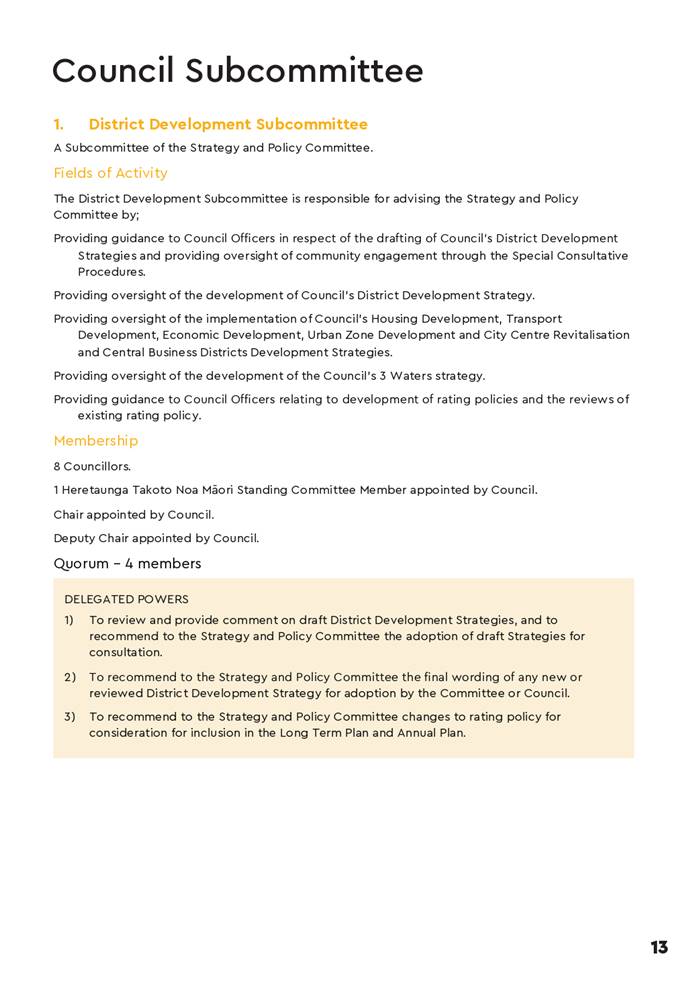

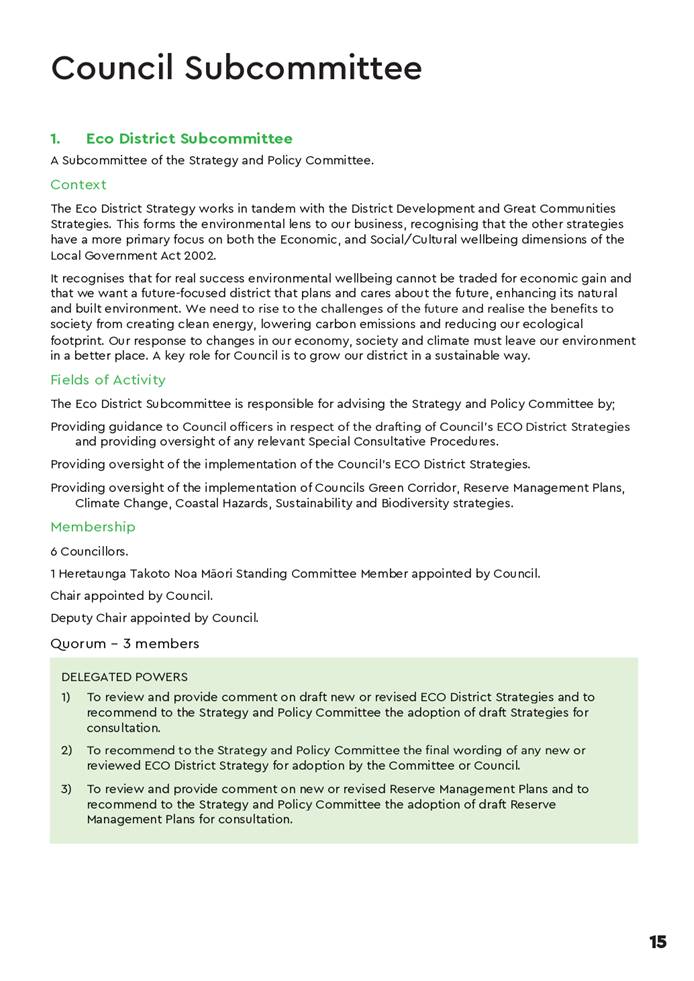

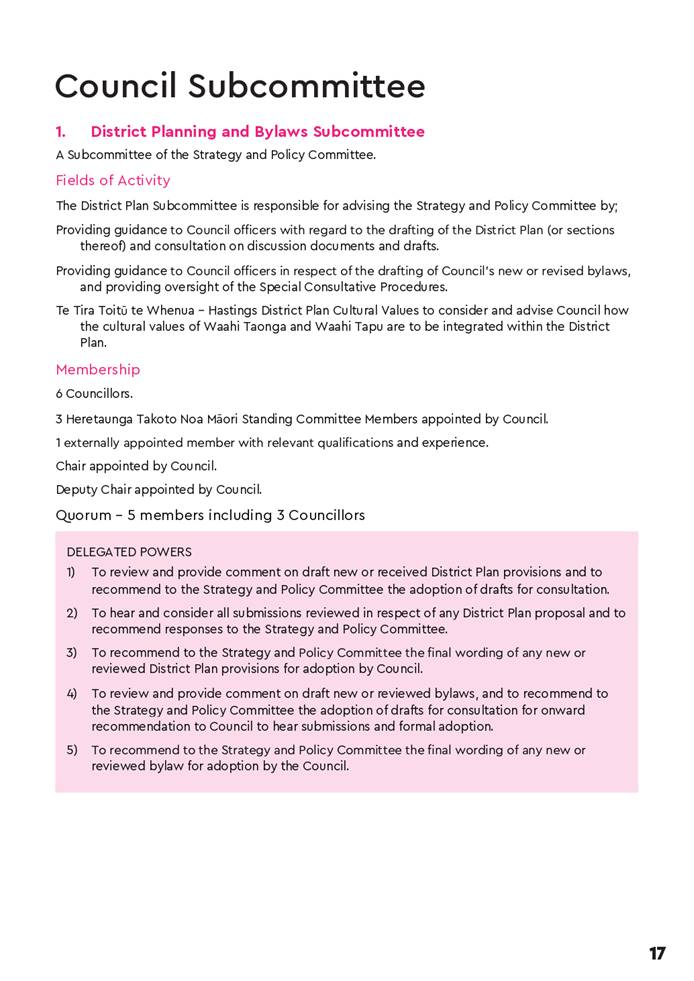






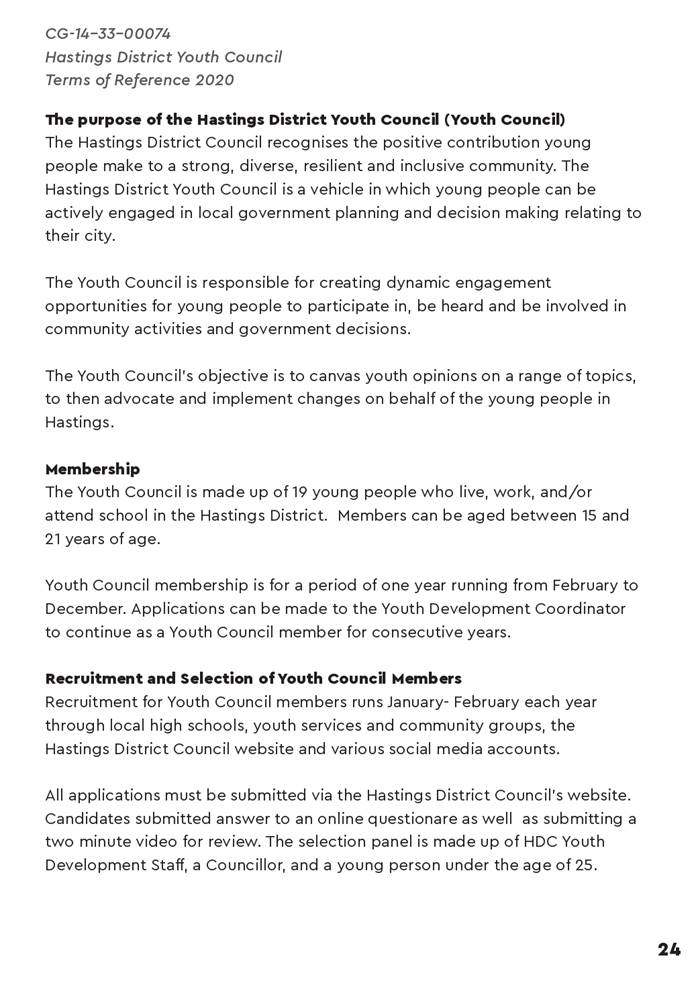
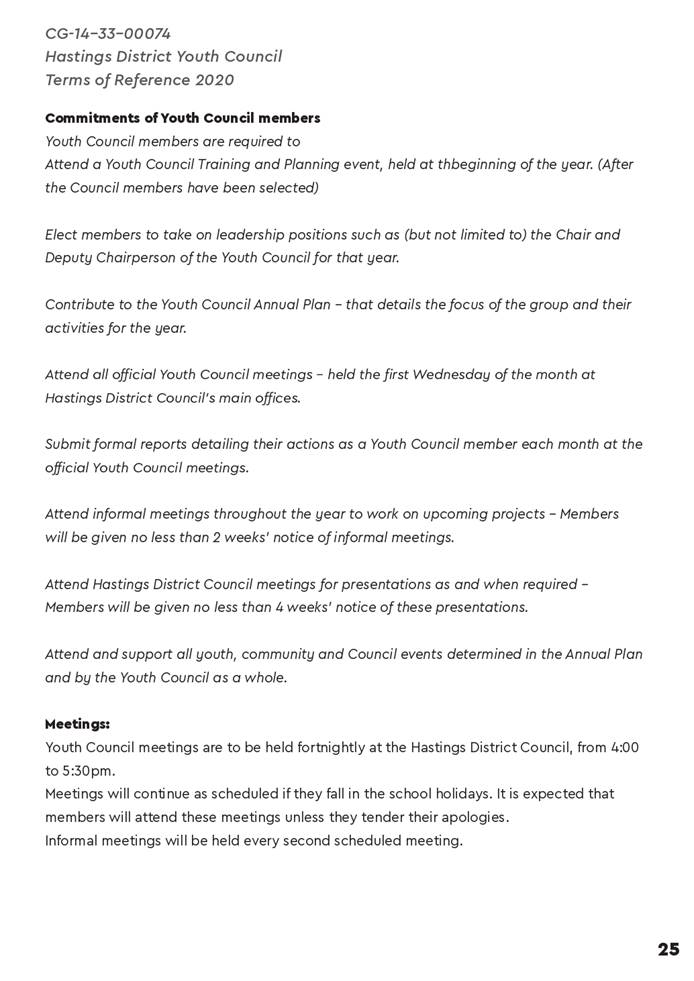
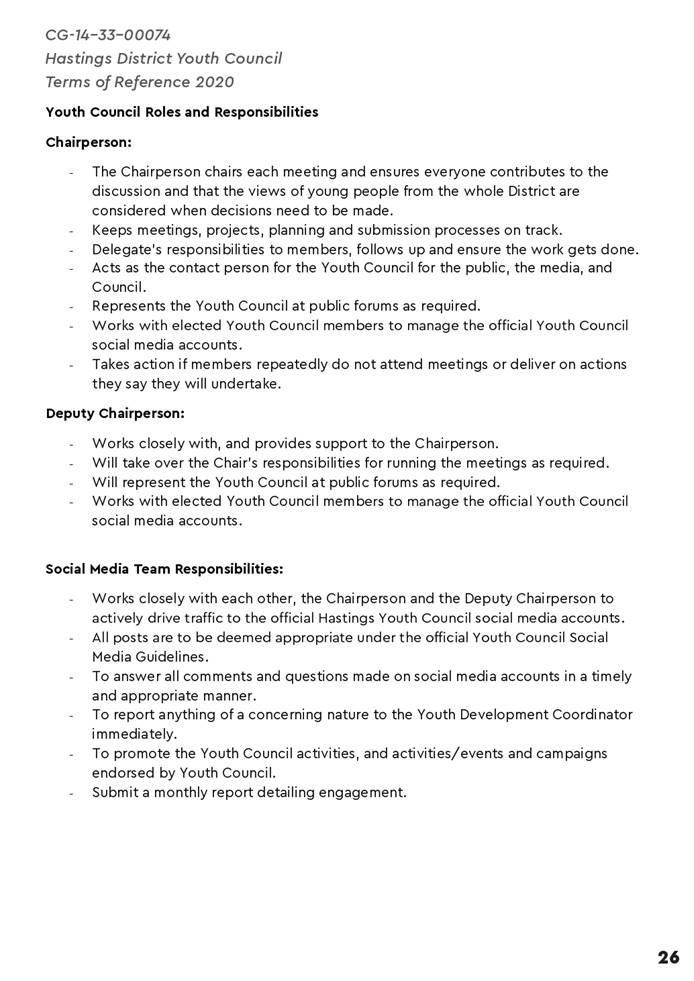
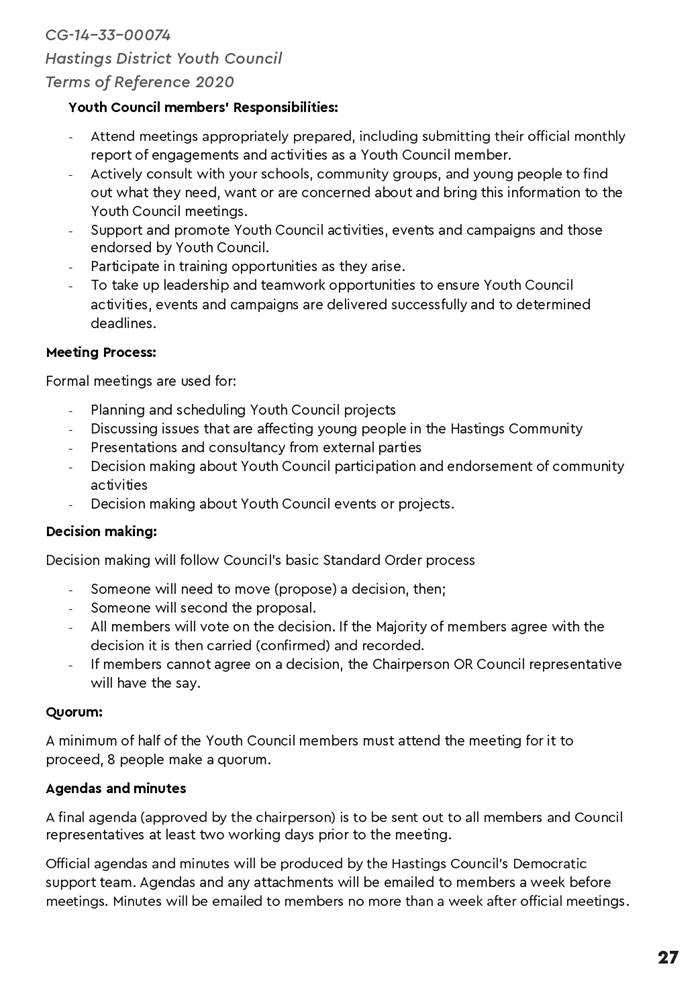

Hastings
District Council: Hastings Youth Council Meeting
Te Rārangi Take
Report to Hastings District Youth Council
|
Nā:
From:
|
Pip Dixon, Youth Connector
|
|
Te Take:
Subject:
|
Active Transport Group
Sub-committee Youth Representative
|
1.0 PURPOSE AND SUMMARY -
TE KAUPAPA ME TE WHAKARĀPOPOTOTANGA
1.1 The purpose of this
report is to table an invitation from the Active Transport Group Sub-committee
for a Youth Council representative on the Sub-committee.
2.0 BACKGROUND – TE
HOROPAKI
2.1 The Active Transport
Group subcommittee meets quarterly and is made up of a mixture of
representatives and includes members from; HDC Councillors, DHB,
Disability Advisory Group, Bike on NZ, Cycle Awareness HB, Sport HB,
Police, NZTA, HDC Officers, HBRC & NCC.
2.2 The purpose of this
group is to provide feedback on the design, development and delivery of
policies, programs and facilities to promote and enhance active transport
mainly cycling and walking within the Hastings District Council Network.
2.3 There are two meetings
remaining for the year 17th September 3-5pm and 3rd
December 2020 3-5pm.
|
3.0 Recommendations – Ngā Tūtohunga
A) That
the Youth Council receives the report titled Active Transport Group
Sub-committee Youth Representative.
B) That
the Youth Council
i. Elect
a representative/s to the ATG Subcommittee.
|
4.0 Discussion – Te Matapakitanga
4.1 Propose
that Tiaki Mildon as Lead and Sophie Jones as an alternate.
5.0 Next steps – Te Anga Whakamua
5.1 Advise the ATG
sub-committee of the nominated Youth Council representative.
Attachments:
|
1⇩
|
Active Transport Group Subcommittee Meeting Minutes 9 July
2020
|
CG-16-25-00011
|
|
|
2⇩
|
Terms of reference for - iway advisory group August 2015
|
PRJ10-8-1832
|
|
|
Active
Transport Group Subcommittee Meeting Minutes 9 July 2020
|
Attachment 1
|
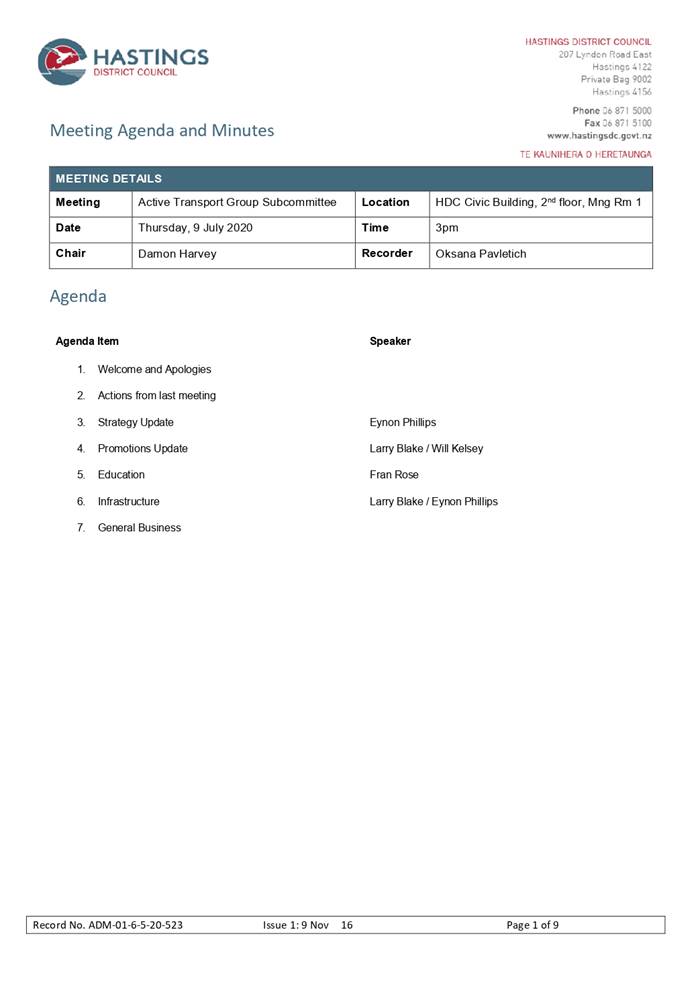
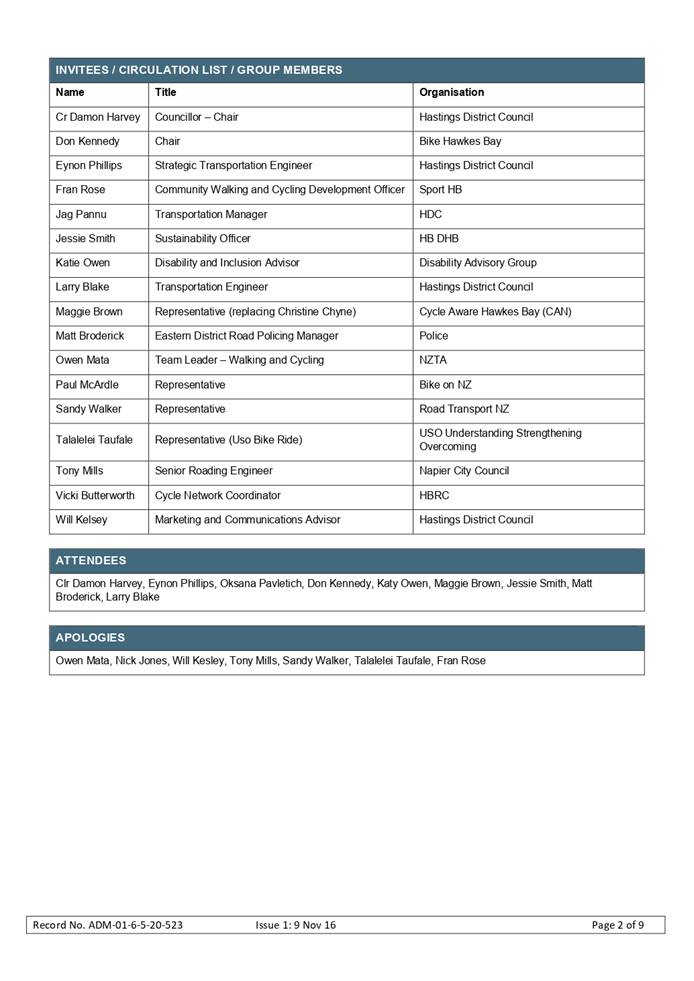
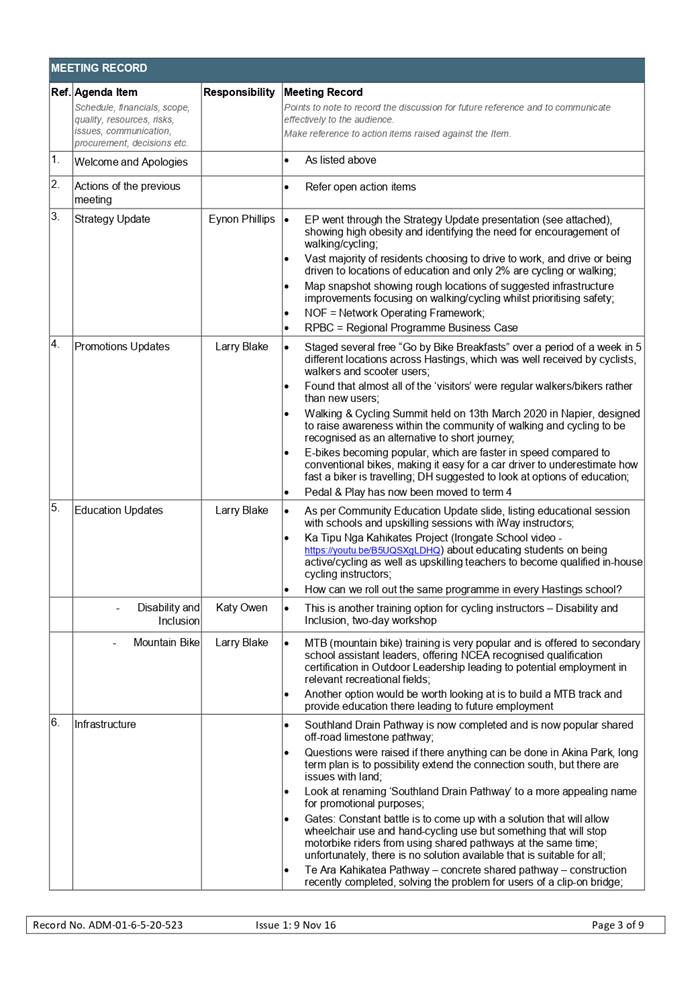

|
Terms of reference for - iway advisory
group August 2015
|
Attachment 2
|

TERMS OF REFERENCE
TRANSPORTATION
ACTIVE
TRANSPORT GROUP
HASTINGS DISTRICT COUNCIL – Transportation
Terms of
Reference
Transportation
2015/16
ACTIVE TRANSPORT GROUP
Prepared and
recommended by: Pune
Brown
Reviewed
by:
Gavin OConnor
Approved by:
Jag Pannu
TERMS
OF REFERENCE FOR THE HASTINGS DISTRICT ACTIVE TRANSPORT GROUP
1. Introduction
1.1 Statement
of Purpose
Hasting District
Council The Land Transport Management Act (2003) has changed the shape of
transport strategies. It takes a broader view of transport strategies than
previous legislation and requires consideration of balance between competing
needs and values. The Land Transport Management Act 2003 sets out the long term
planning for transport at a national level under guidance from the New Zealand
Transport Strategy. The strategy sets the following national objectives for
transport consideration:
· assist
economic development,
· assist
safety and personal security,
· improve
access and mobility,
· protect and
promote public health,
· ensure
environmental sustainability.
To give effect to this
requires forecasting a long-term strategic approach to transportation aimed at
achieving ‘an affordable, integrated, safe, responsive and sustainable
transport system’. Achieving this will require utilization of improved
technology by influencing choices that the travelling public makes.
In order to operate the
district transportation system in a way that contributes to an integrated,
safe, responsive and sustainable transportation network, Hastings District
Council will seek to actively manage the demand for travel on its
transportation network. This will be done by making a more efficient use
of the existing road network and by influencing travel decisions and encourage
the use of more sustainable travel modes such as public transport, cycling and
walking.
The District Travel
Demand Management Study Review will support Hastings District Council in
achieving a district wide Transportation Strategy by providing a framework
coupled with network wide and area focused plans and strategies, to manage all
modes of origin and destination travel throughout the district whilst improving
safety, providing travel choices, maximizing the utilization of the existing
network and reducing congestion. The study will understand gaps in
optimization knowledge of planning and respond to these gaps in areas projected
to experience demographic or other change pressure not accounted for in
existing studies.
1.2 Purpose
and Study Objective
Purpose
Hastings District Council Travel Demand
Management Study Review will look both at the required measures and strategies
to manage demand both at a macro and micro levels. This will ensure that
such strategies are targeted not only on a district level but also on a
individual key strategic link and area community level. It will also help
ensuring that a controlled investment is aligned to government policy over the
longer term.
Objectives
The objectives of the travel demand study are:
1. Assist and promote
economic development, by:
· Support the district
transport strategy, Regional Land Transport Strategies (RLTS),Regional Policy
Statements (RPS), development of regional strategic growth plans, Regional Land
Transport Programmes (RLTP)
· Optimise existing
significant transport investment
· Contribute to
businesses growth and productivity
1. Assist
safety and personal security, by:
· Contribute to positive
health outcomes
· Encourage healthier
transport modes (i.e. walking and cycling)
· Reduce deaths and
serious injury as a result of road crashes
2. Improve
access and mobility, by:
· Reduce congestion at
key areas
· Improve journey time
reliability at peak times
· Reduce private vehicle
travel, especially at peak travel times
· Promote the use of more
efficient transport modes
· Provide more transport
choices
3. Ensure
environmental sustainability, by:
· Reduce adverse
environmental effects
· Improve air quality
· Reducing fuel
consumption
· Reducing the use of
non-renewable resources
1.3 Context
and Scope of Study
The
goal of the Hastings District Travel Demand Management Study Review will be to
identify a number of measures to manage the demand for travel and improve the
efficiency of the road network while encouraging more sustainable transport
modes. Managing the travel demand will help to reduce marginal costs by
reducing the amount of road users who, under normal circumstances, would
contribute to congestion and, therefore, cause additional costs to other users.
It
will identify current and anticipated levels of service and land use patterns
and highlight the main challenges and how council will respond to meet the
needs of the community over the longer term. The outcome of the Travel
Demand Management Study Reviewwill enable specific measures and strategies to
be implemented to improve the efficiency of the existing network and
accommodate changing travel and land use patterns, including opportunities for
alternative modes of transport.
The
factors and patterns to be considered include:
· Traffic and safety
· Land-use
· Demographic
· Economic
· Environmental
· Social
· Cultural
· Employment
· Commuting peak hours
· Tourism
· Health services
· Education
· Technological
· Legal
· Sustainability
· Public transport modes
The
modes and elements to be considered are:
· Active Transport
– Walking and Cycling
· Public Transport
– Road and Rail
· Freight Transport –
Road and Rail
· Private Transport
– Private vehicles
· Modal interchanges
– Need and positioning
1.4 Area
and Location of Study
The study will focus on the main population
areas within the Hastings District, namely Hastings, Havelock North, Clive and
Flaxmere.
The Heretaunga Plains Transportaton Study has
identified key corridors that will reach unacceptable levels of service between
2010 and 2046. The Travel Demand Study will focus on these routes to examine
travel demand management solutions that could extend the timeframe for major
infrastructural projects on these routes or eliminate them completely.
The key routes are:
· St Aubyn Street
· Karamu Road
· Heretaunga Street East
and West
· Havelock Road
· Pakowhai Road
· Mareakakaho Road
· Omahu Road
· Te Mata Road
2. Study
Framework
2.1 Transportation
Modes
The Travel Demand
Management Study Review aims at improving accessibility for employment,
education, health, retail and other services. As such, it requires an
optimised balance between all transport modes and components of walking,
cycling, public transport, cars and heavy transport.
In achieving the level
of optimisation required for the success of this plan it is required to engage
local authorities, public transport operators, heavy transport operators,
retailers, employers and other stakeholders.
2.2 Methodology
Transport is important for many areas of
government policy and, therefore, the Hastings District Travel Demand
Management Study Review will be influenced by a number of existing strategies
especially the Regional Transport Strategy, New Zealand Transport Strategy and
those relating to land-use. In addition, there will be an extensive process of
stakeholder engagement.
It is envisaged that the following methodology
will be used:
1. Background research,
evidence gathering and data collection:
· This will help
establishing the main traffic corridors, type of travelling (e.g. commuting,
visitors, retail) and peak times
· Largely supported and
based on the existing Heretaunga Plains transport model to define trips origin
- destination and production – attraction characteristics
· Research into existing
road, cycling, pedestrian and public transport infrastructure
· Research into existing
travel patterns and modes of transport
· Research into existing
policy, strategy and district plan documentation
2. Define problems,
issues and opportunities: this will help establishing a ‘Current
Scenario’ where future travel demand management measures and strategies
can be tested to assess their performance.
3. Define a vision,
objectives and targets. These will include:
· Creating a more
efficient transportation network
· Influence travel
decisions to encourage more sustainable travelling
· Create an integrated,
high quality public transport system
· Definition of the
required level of service for the road network
· Creating pricing
mechanisms to influence travel demand
· Defining educational
and promotional initiatives
4. Establish the future
scenario Hastings District Council (HDC) wants to achieve. The definition
of this ‘Ideal Scenario’ will assist HDC in the evaluation of
travel demand measures, policies and strategies.
5. Identify Travel
Demand Management measures, policies and strategies which will take HDC from
the ‘Current Scenario’ to the ‘Ideal Scenario’.
· It has been established
that packages of measures are likely to be more effective than individual ones
· Such measures and
strategies will be coordinated with other existing strategies and policies,
e.g. land use policies
6. Create an
implementation plan. This plan is to look into:
· Short term measures
– less than 5 years
· Medium Term measures
– between 5 and 10 years
· Long term measures
– between 10 and 20 years
7. Establish a
monitoring and review process. This is will assist HDC to asses the level
of success of the Travel Demand Management Plan and to identify additional
measures that need to be put in place
A number of tools and documents will be used in
the development of the Hastings Travel Demand Management Study. These are
listed below as:
· Regional Transportation
Model
· Hastings Area Urban
Transportation Model
· Regional Transportation
Strategy
· New Zealand Transport
Strategy
· Land use plans and
strategies
· Accessibility Mapping
· RAMM
· GIS
· Public Transport
Operators information
· Central Region Freight
Analysis Report( NZTA)
Some of the Travel Demand Management measures
that could be considered include:
Soft measures
· Restrictions on parking
control
· Incentive schemes such
as a ‘loyalty card’ or electronic transponder system which could
provide cyclists/pedestrians reductions off their rates for using these modes
on routes such as the Havelock Road in commuter hours
· Promote flexible
working hours with local employers
· Promote changes in
school times with local schools
· Review of land use strategies
to encourage mixed developments
· Request local schools
to produce travel plans
· Create freight
management policies to restrict access to the CBD during peak times
· Bike hire from motels
and other locations
· Dedicated website
promoting alternative forms of travel or carpooling
· Changing district plan
policies to take into account travel demand management initiatives as part of
the subdivision and consent process
Hard measures
· Introduction of Park
& Rides:
· Integrated public
transport with new interchanges
· High Occupancy Vehicle
lanes (HOV)
· Bus priorities and
dedicated bus lanes
· Improve cycling and
walking infrastructure
· Provision of ancillary
infrastructure to encourage walking and cycling
· Introduction of new
public transport modes, e.g. Light Rapid Transit, Bus Rapid Transit, Monorail,
etc.
· Creation of
distribution centre in CBD to eliminate need for heavy vehicles mixing with
retail area
· Create pedestrianised
areas
2.3 Timeframe
and Estimated Cost
The review will be undertaken by 1 July 2017.
The estimated fee for the Travel Demand Plan is
$60,000.
Funding is applied for under Work Category 002:
Studies and Strategies.
2.4 Study
Partners
· Hastings District
Council
· Hawke’s Bay
Regional Council
· New Zealand Transport
Agency
· New Zealand Police
· Heavy Transport
Companies
· Public Transport
Companies
· Walking and Cycling
Groups
· Road Safe HB
2.5 Procurement
The procurement of the Travel Demand Study will
be delivered through the use of the approved procurement strategy.
3. Outcomes
and Deliverables
3.1 Outcomes
The outcome of this
study is a District Travel Demand Management Study Review which will provide
detailed measures and strategies to manage travel demand throughout the
district. It will be based on current and anticipated levels of service and
land use patterns identified within the District Transportation Study and the
Heretaunga Plains Transportation Study and highlight the main interventions
necessary to meet the objectives therein specified.
The outcome of the plan
will enable the implementation of network upgrades, safety improvements,
retrofitting and planning road corridors to manage travel demand and
accommodate changing travel and land use patterns and policies, including
opportunities for alternative modes of transport.
3.2 Final
Deliverables
Upon completion of the strategy, a final
document entitled “Hastings District Travel Demand Management Plan”
will be produced. The following information is required in the report as
a minimum:
· Executive Summary
· An outline of the
method used
· Visions and objectives
· Fit with strategic direction
of the RLTP objectives
· Identification of the
preferred travel demand management strategy and measures to address the
following:
o Transportation system development and
improvement
o Active transport (walking and cycling)
o Public transport
o Parking
o Heavy transport and freight
o Travel demand management
o Education
o Enforcement
o Regulation and enforcement
· Consultation strategy
· Recommended measures and
actions for the key routes
· Implementation programme
(costs, funding, timeframes and phasing) for the package of measures and
actions
· Relationship to other existing
strategies
· Identification of amendments
required to existing strategies
· Conclusions and recommendations
 Te Hui o Te Kaunihera ā-Rohe o Heretaunga
Te Hui o Te Kaunihera ā-Rohe o Heretaunga


































